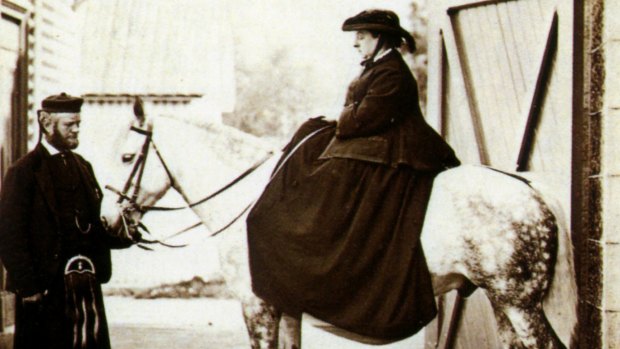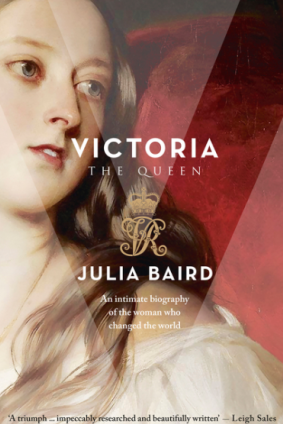By Lucy Sussex
BIOGRAPHY
Victoria the Queen: An Intimate Biography of the Woman who Ruled an Empire
JULIA BAIRD
HARPERCOLLINS, $72.95
In the 19th century, ultimate power resided within a little black dress. On a tall woman it would have reached the knees, but since its wearer was less than five feet, and even shorter when aged, it covered her decently from neck to toe. It was lacy and frilled, but otherwise plain, a statement of mourning. The waist was wide, uncorseted, for this woman liked food and hated constraints. She ruled over a vast empire, a constitutional monarch in an era when women were otherwise denied rights. She was Queen Victoria, Britannia Gloriatrix, the embodiment of her time.

Queen Victoria and John Brown.
In life, the Queen was formidable. In death, she presents major problems for the biographer, not the least being the hagiography that saw much of her writings destroyed or censored. Her life was long, well-documented, and contained a cast of thousands, many relatives. She also lived through a period of extraordinary change, in areas ranging from the technological and philosophical to the social. The era produced Darwin, Marx, Wilde – but also wars, repression and colonial land-grabs.
How can such a panorama be contained within the compass of a book? Many have tried, from Lytton Strachey to Christopher Hibbert. Inevitably, each decade views Victoria via its own preoccupations. Julia Baird, the latest in the lineage, has academic history training, but is primarily a political journalist. The book consequently is written with a journalist's facility, a historian's research, and with much empathy for an often difficult woman. It comprises a political, feminist guide to Victoria. Small wonder the book's blurbs come from Leigh Sales and Annabel Crabb.

Victoria the Queen, by Julia Baird.
Baird does not claim Victoria as feminist – she had no time for female suffrage. Her exceptionalism was sincere, for a queen did not need the vote. As a successful and strong woman in an era of near-total patriarchy, she fully deserves the feminist approach. And since the head of a nation, however symbolic, is necessarily a political animal, it is folly to consider Victoria only as a domestic female, mother and wife. If anything, Victoria was a British lioness, fiercely protective and deadlier than the male.
Baird's view of Victoria is timely, given that women in power remain regrettably problematic: particularly in Australia and with the 2016 US election. Unlike Julia Gillard and Hillary Clinton, Victoria had few qualifications for her role beyond birth. She was naturally robust, but, if somewhat under-educated, was intelligent, and extremely tough. Men tried to control her, but only one really succeeded: Prince Albert, during a time when constant childbearing left Victoria debilitated, and even postnatally depressed.
In the two decades of their marriage, Victoria did conform to the contemporary ideal of the woman as ivy, twined around the masculine oak. Otherwise, she was steely, independent, and in control.
Prince Albert seems admirable rather than likeable, despite the Queen's adoration. It did not stop them having terrific spats. Baird quotes some of their small surviving correspondence, in which he called her "my child" and lectured her unmercifully. Albert was faithful, well-meaning, and had a reform agenda. To him, she was an intellectual inferior, without acknowledging her real shrewdness and strength. He was also a control freak extraordinaire, watching her maids dressing her, and offering fashion critiques. His micromanagement became obsessive, as this king without the title worked himself to death at the age of 42.
The Queen, left with a kingdom and nine children, one with haemophilia, was grief-stricken. She went into seclusion, justifiably, given the many attempts to assassinate her. If she felt herself utterly alone, it was something she had known before, in her teen years. As a young girl she had fought as fiercely as the young Elizabeth I for her integrity, if not head. Approaching menopause, with its surge of new energies, she drew on that self-reliance, and survived another 40 years.
The most recent reputable biography of Victoria, by A. N. Wilson, gave space to her politics, but for Baird it is a major focus. The Queen worked closely with her prime ministers, and her politics being personal, her increasingly Tory stance had more to do with dislike of the reformist Gladstone, and friendship with Disraeli. Gladstone, like Albert, considered women inferior; Disraeli did not, even favouring female suffrage.
Other prime ministers paid tribute to her industry and good sense: Lord Salisbury said: "She knows what she is talking about." She might not agree with her ministers, but they got her opinions, strongly and cogently argued. Her portfolio was her Queendom, later Empire; and she was on top of the subject.
To read this book is to see myths challenged, about Victoria, feminine rule, and the 19th century. On a personal level the Queen was amused, and highly sexual. She also presided over a great era of reform, which improved the lives of millions. Yet, as Baird notes, it also contained some of the worst excesses of colonialism. That is one contradiction, but the Queen was a mass of them. "People are complex," Jenny Macklin said of Kevin Rudd. How else could Victoria have recovered from the loss of Albert with John Brown?
The nature of their relationship has been obscured by determined censorship from the Queen's children. It continues, despite Mrs Brown: Baird was asked by Buckingham Palace to remove matter from the diaries of the Queen's last doctor. She refused, having struck gold, a witness statement of flirtation – although flirting acknowledges sexual attraction without necessarily acting upon it.
More significant is that the Queen instructed she was to be buried with a ring from Brown upon her small hand. As with discussions of historical lesbians, where sexual acts cannot be proved, they become immaterial. What really matters is love, and Baird states categorically that Victoria loved Brown.
In her enterprise, Baird has been aided by Victorianist and researcher Catherine Pope. I located only one mistake, likely a proofreading cut. Nor did I feel the urge to check the sources for a dubious detail, to find the author had made stuff up.
More problematic to historians here is the occasional creative non-fiction, where the writer not only imagines themselves into a scene, but into the head of the protagonists. The past is truly foreign, and we cannot know how people thought, only their words and deeds. Thus, the section devoted to Victoria's marriage reads somewhat like a historical romance, although we are spared the sex scene. It is true to the Queen's highly sentimental spirit, but still off-putting.
These quibbles apart, Baird's book is to be commended. She does not, like Wilson, get mired in a mass of detail, sensibly avoiding the complications of the extended royal family, where biographers are apt to get confused. The book is 500 pages, but nary wastes a word. She is also able to move towards a better sense of narrative closure: Victoria dying in her grandson Kaiser Wilhelm's arms, in the middle of the Boer conflict, and with the First World War already foreshadowed.
The book ends with another contradiction: Victoria might not have approved of suffragettes yet her example, of a capable woman in power, surely inspired them. In brief, Baird nails Victoria, with sympathy but not uncritically. There can be no higher praise.
Lucy Sussex is the author of Blockbuster! Fergus Hume and The Mystery of a Hansom Cab (Text).